Abstract
Amber mutants of the related phages T3 and T7 were isolated and tested for their ability to restore—as the wild type does—thymidine incorporation in ultraviolet (UV)-irradiated, UV-sensitive, nonpermissive host bacteria (Escherichia coli Bs-1). Most amber mutants had this ability. However, in both T3 and T7, mutants unable to promote thymidine incorporation under these conditions were found and classified into two well-defined complementation groups: T3DO-A and T3DO-B, T7DO-A and T7DO-B. Infection of Bs-1 cells with representatives of groups DO-A had the following characteristics: (i) phage-directed uridine uptake in UV-irradiated cells was reduced to less than 20% of normal; (ii) breakdown of host deoxyribonucleic acid (DNA) was delayed and incomplete; (iii) no serum-blocking antigens appeared; (iv) no cell lysis occurred; (v) the ability to exclude the heterologous wild type was impaired. Amber mutants of the DO-B groups, infecting Bs-1, were able to: (i) promote an efficient phage-directed uridine uptake in UV-irradiated cells; (ii) bring about rapid breakdown of host DNA; (iii) synthesize serum-blocking antigens; (iv) lyse the host cells, generally after the normal latent period; (v) exclude efficiently the heterologous wild type. Although physiological similarities between the respective DO-A mutants or DO-B mutants of T3 and T7 were evident, no physiological cross-complementation occurred, and genetic crosses gave no evidence of genetic homologies between groups of T3 and T7.
Full text
PDF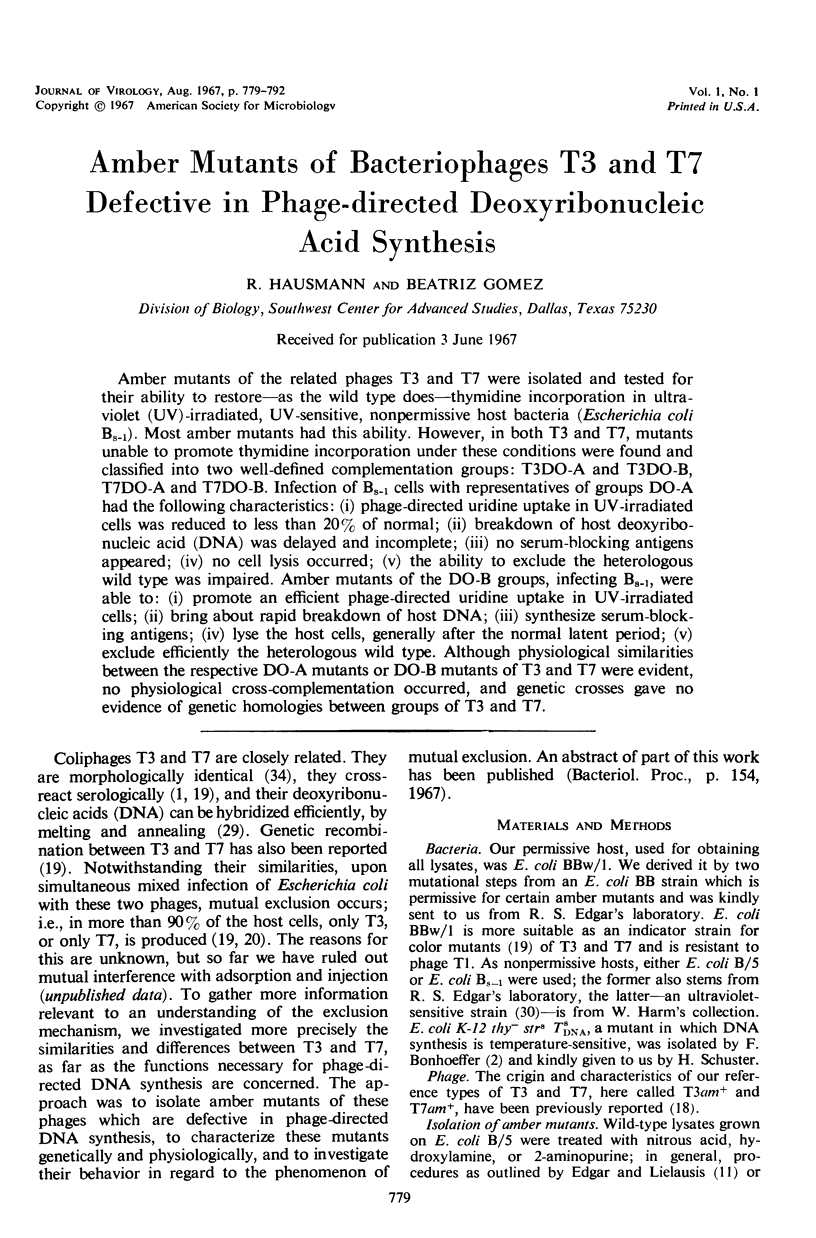
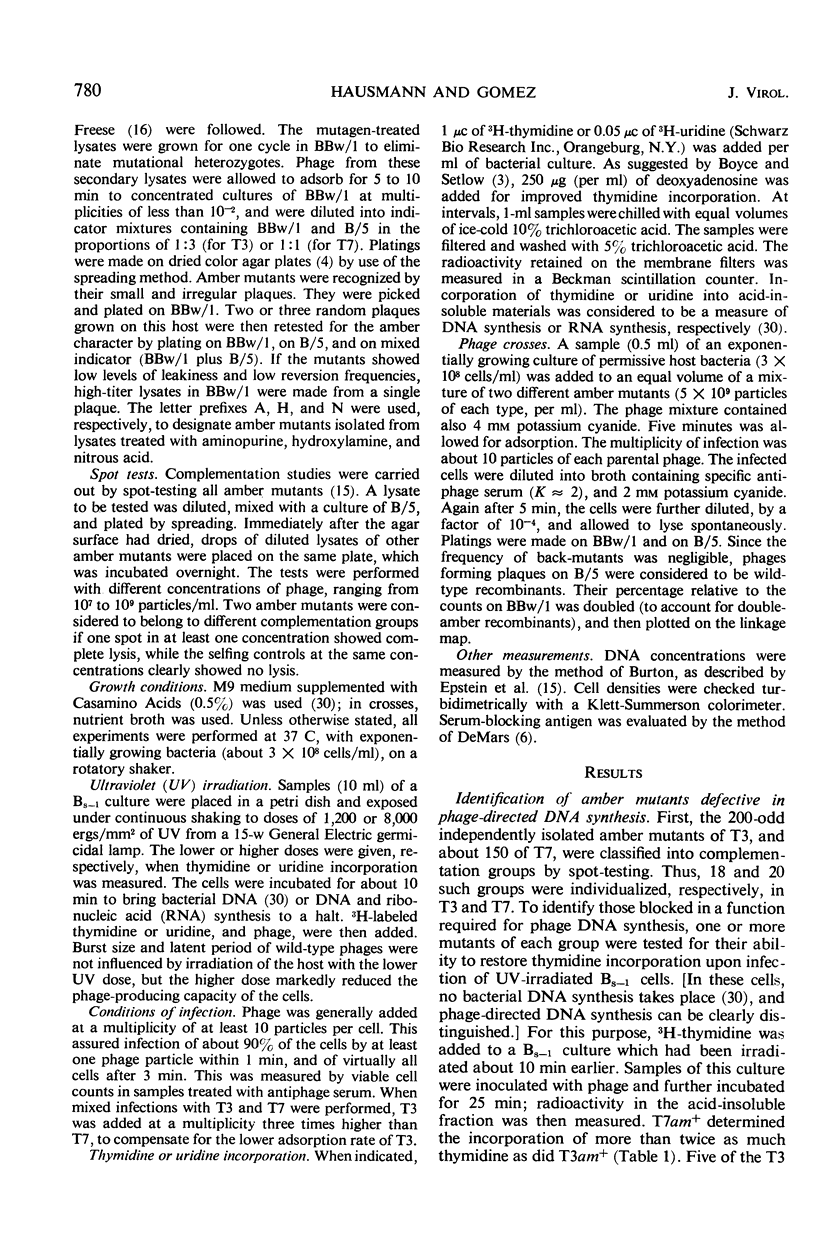
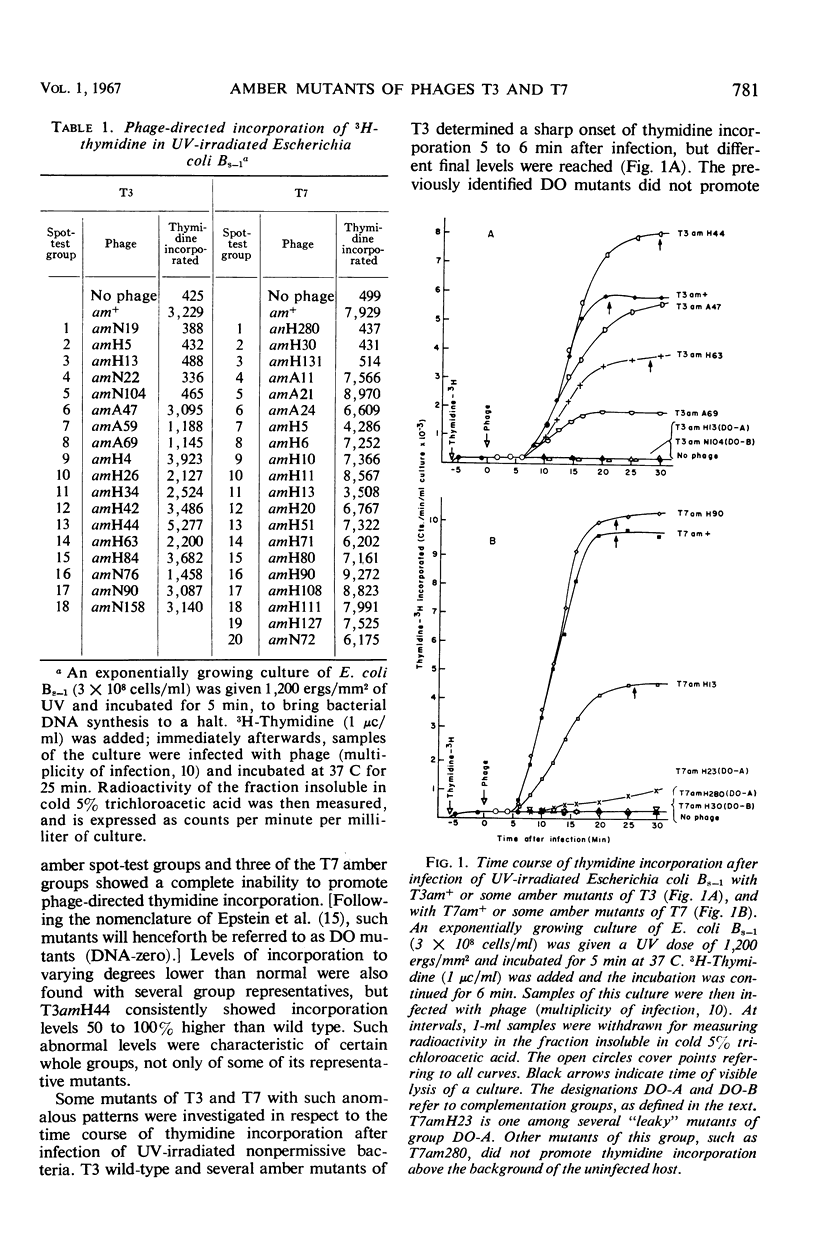
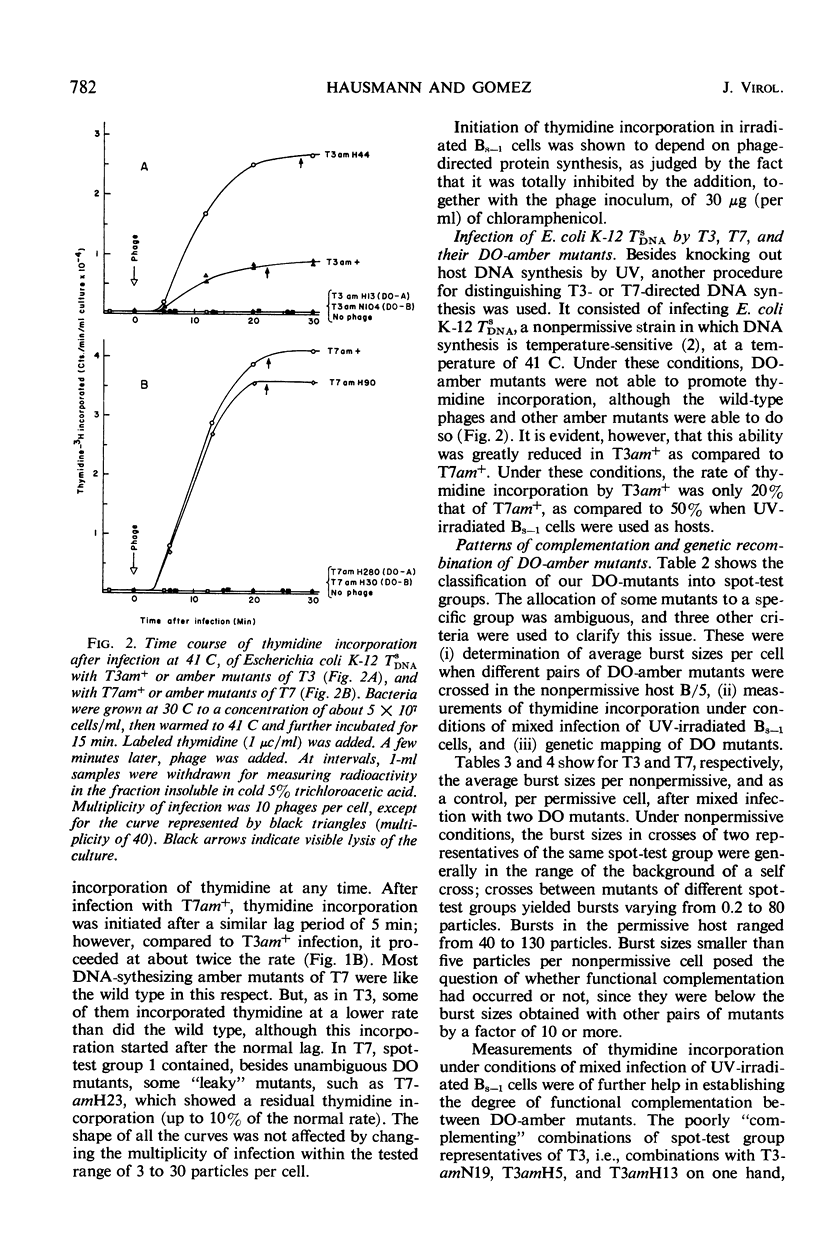
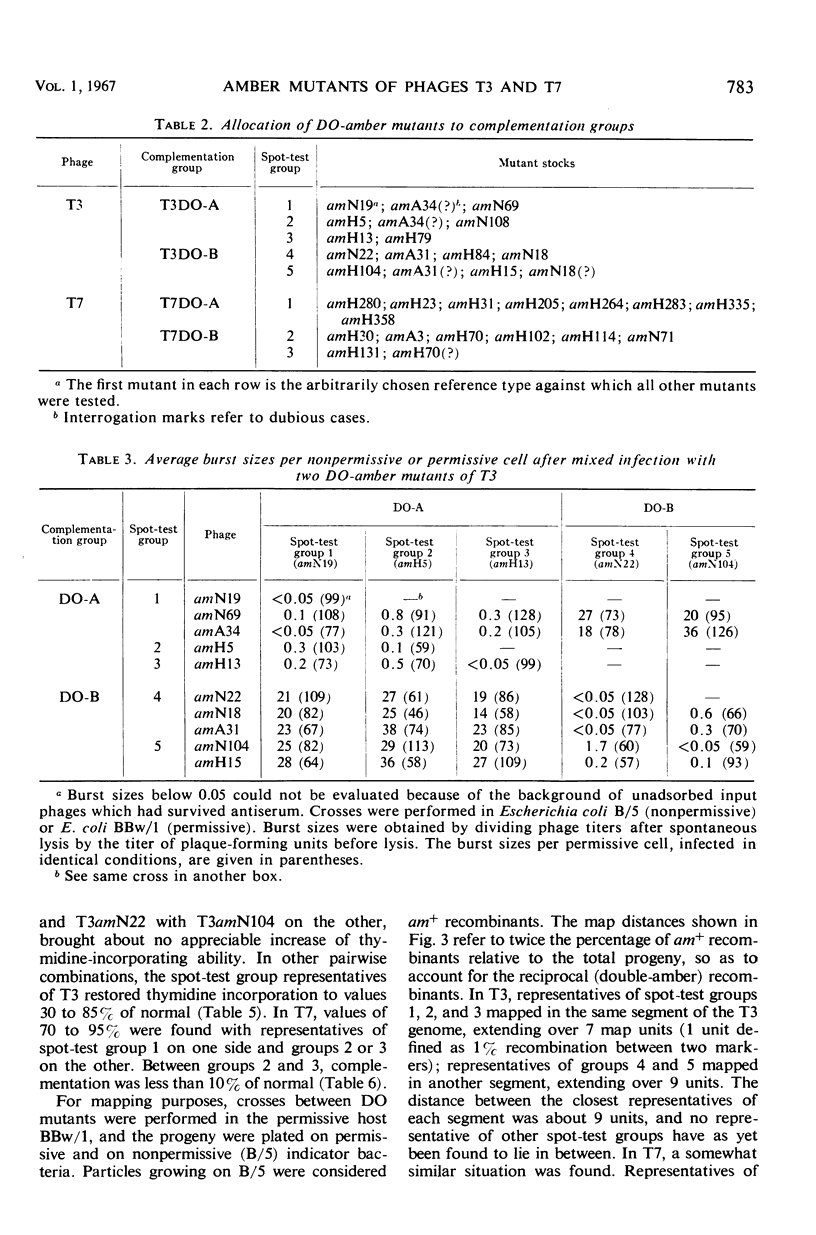
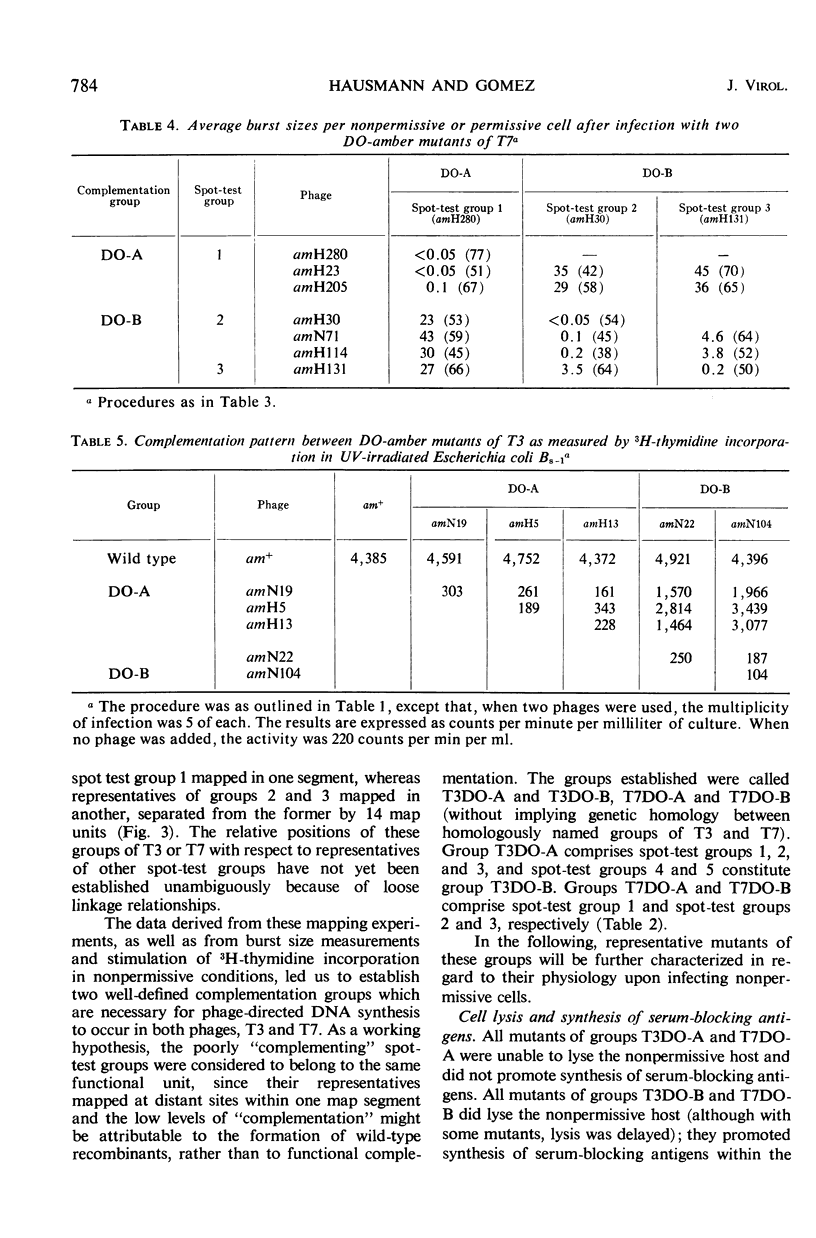
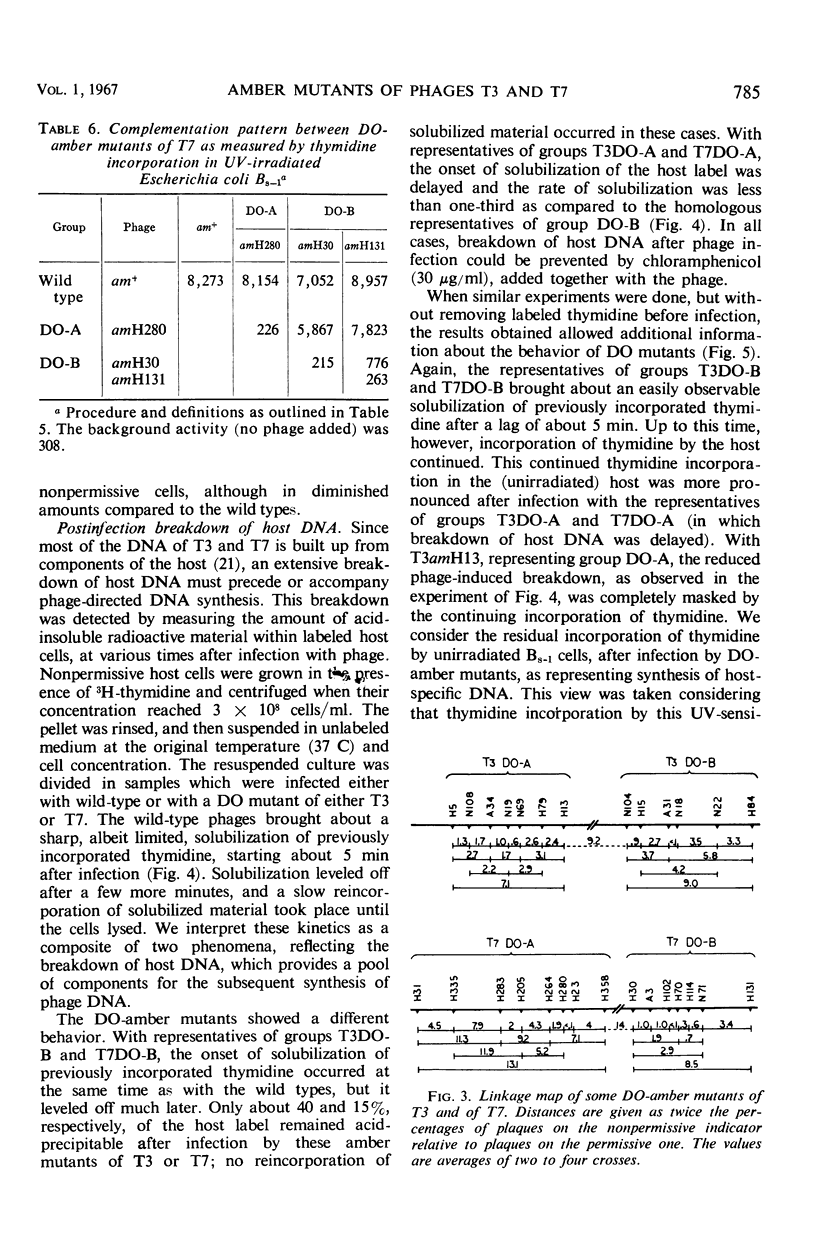
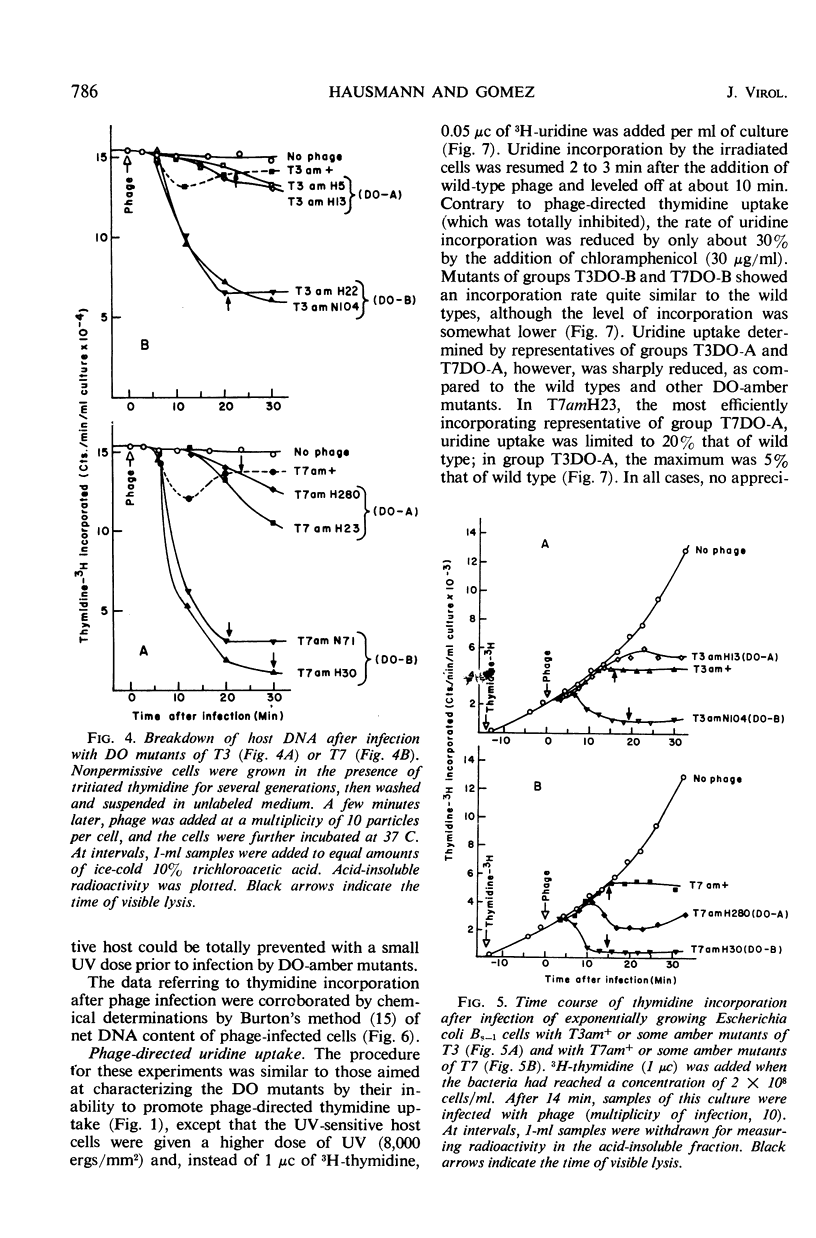
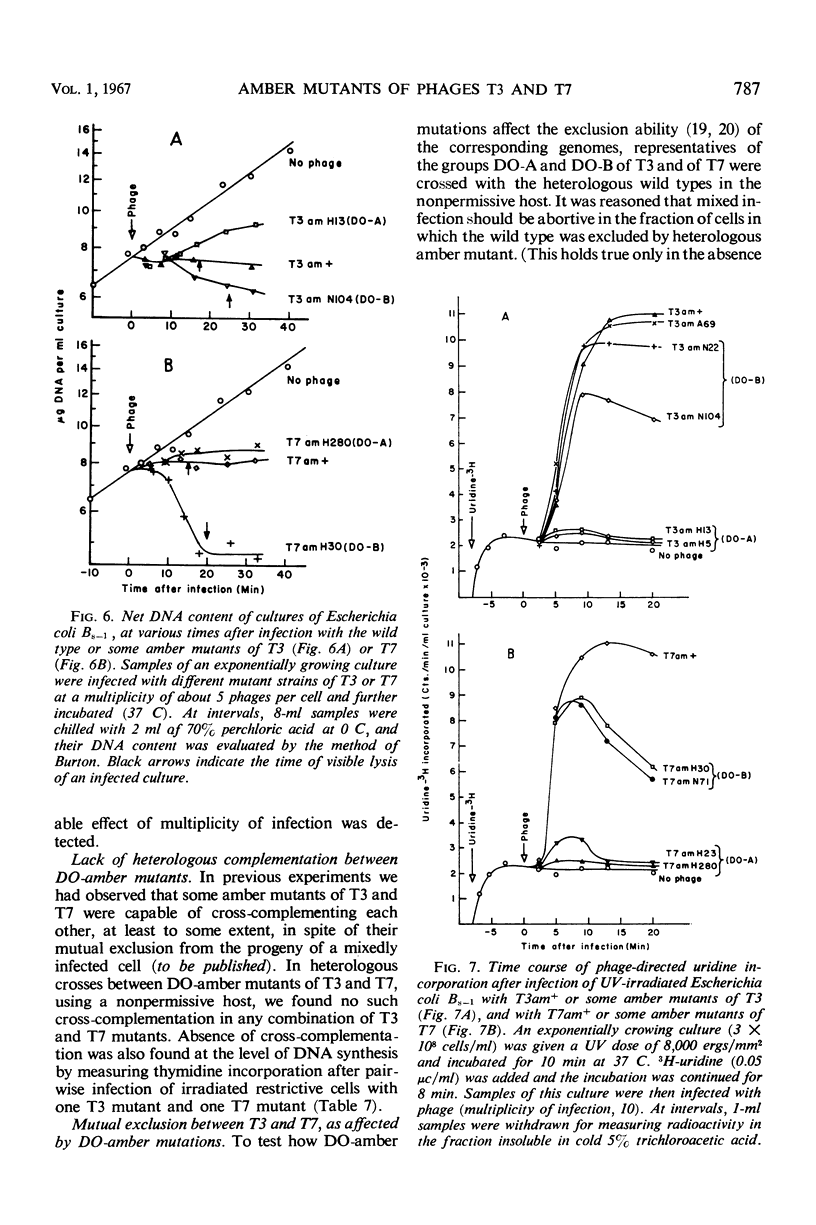
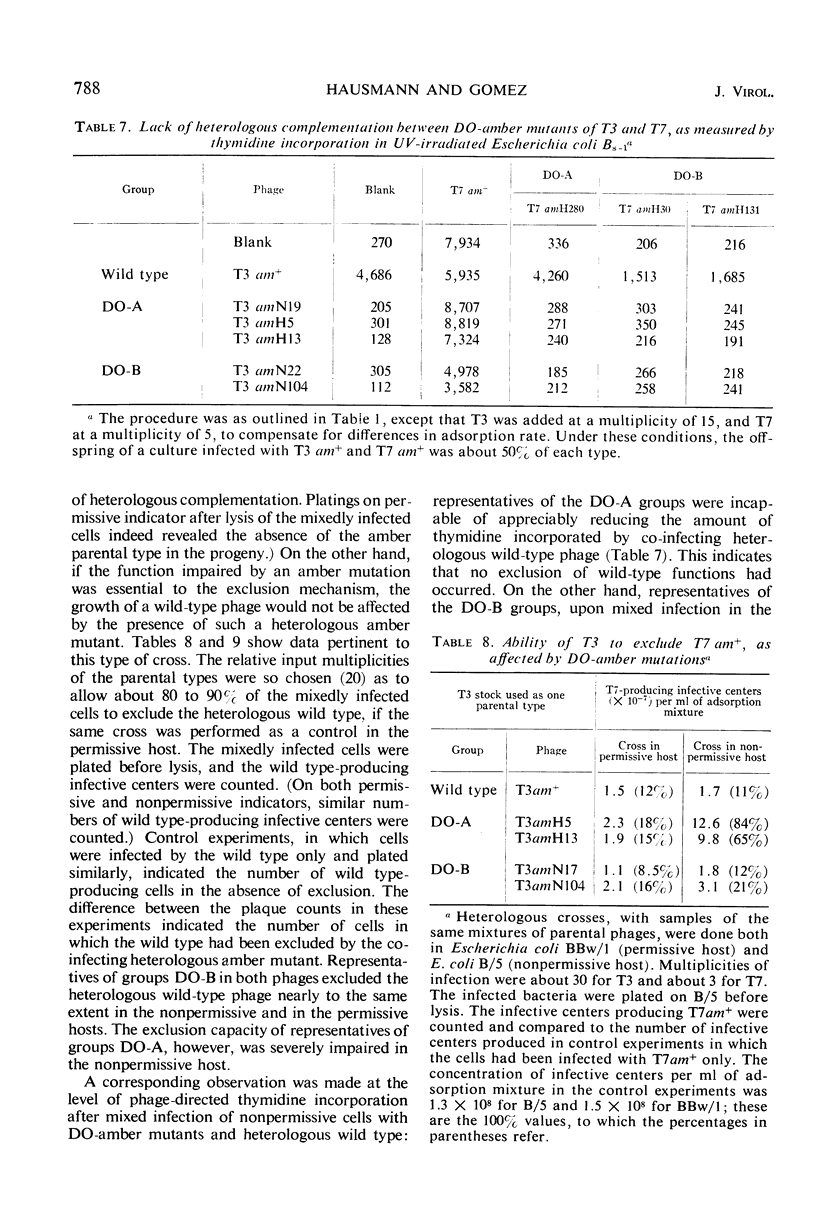
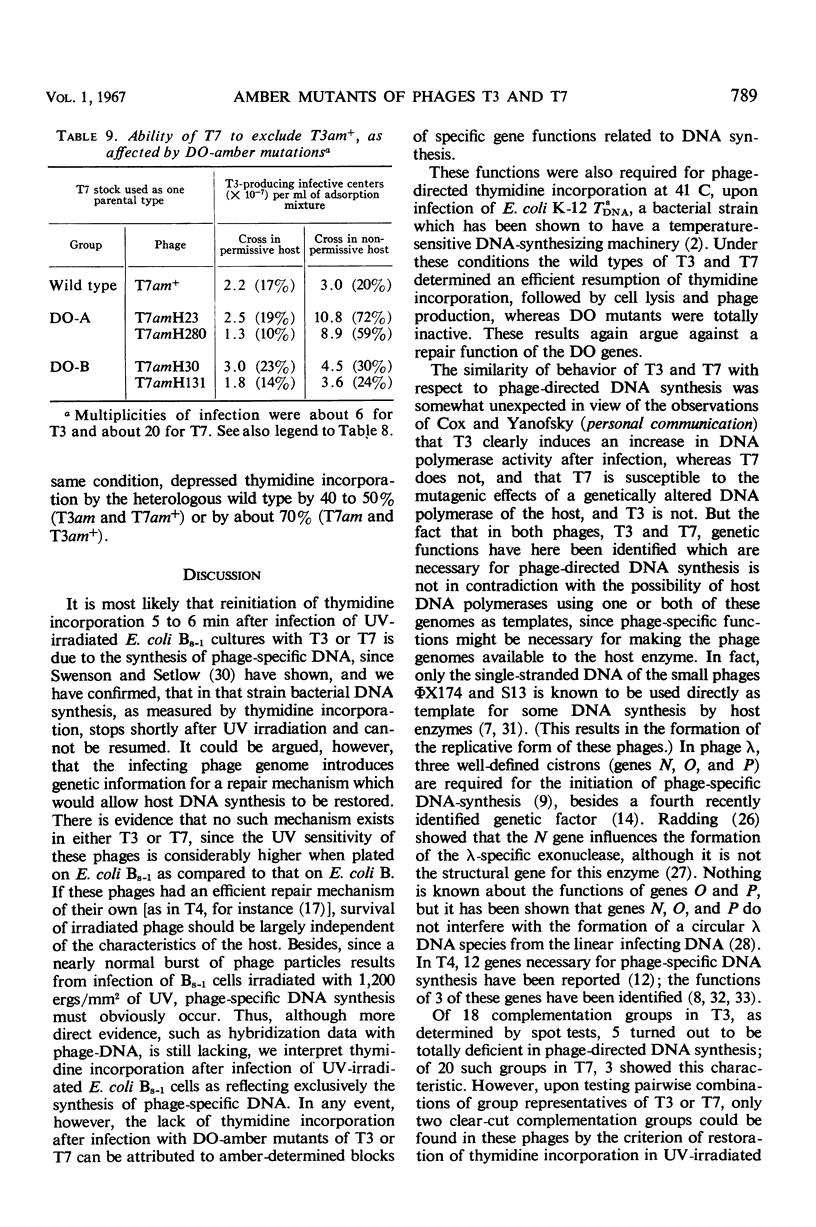
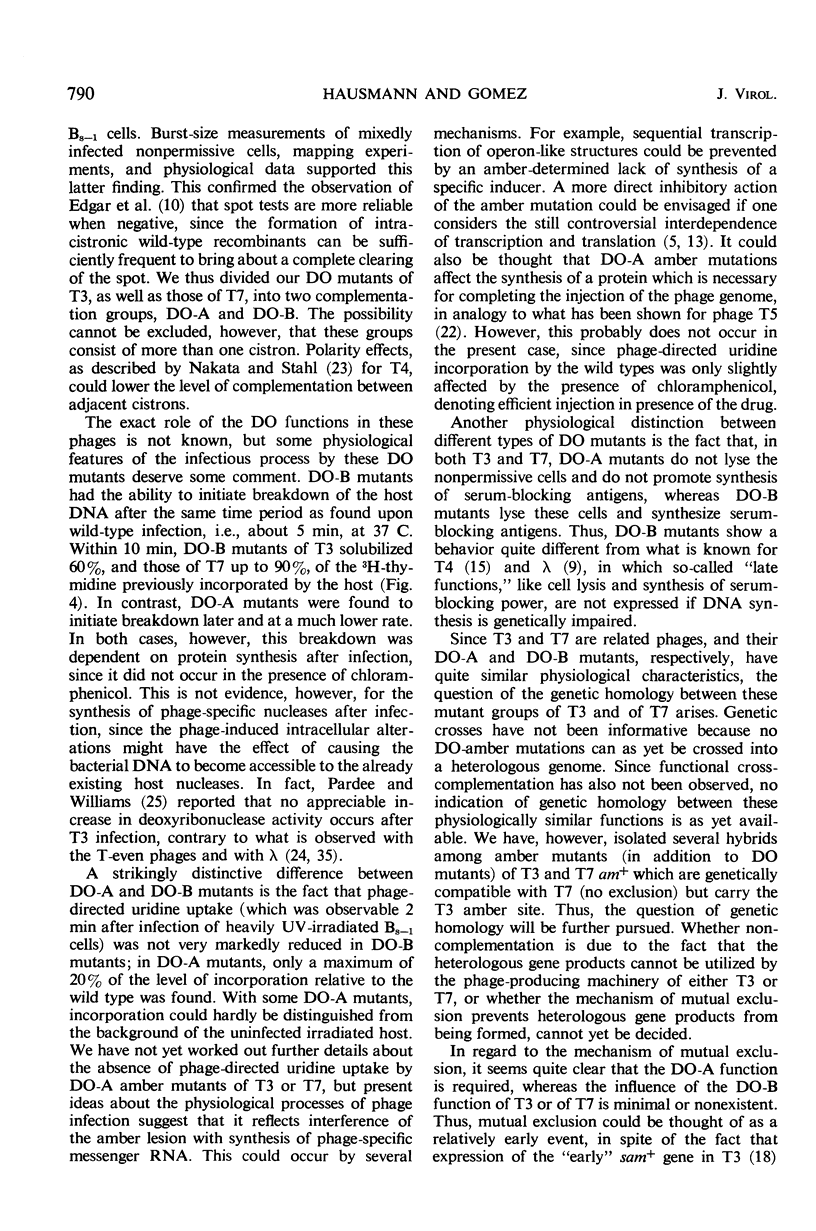
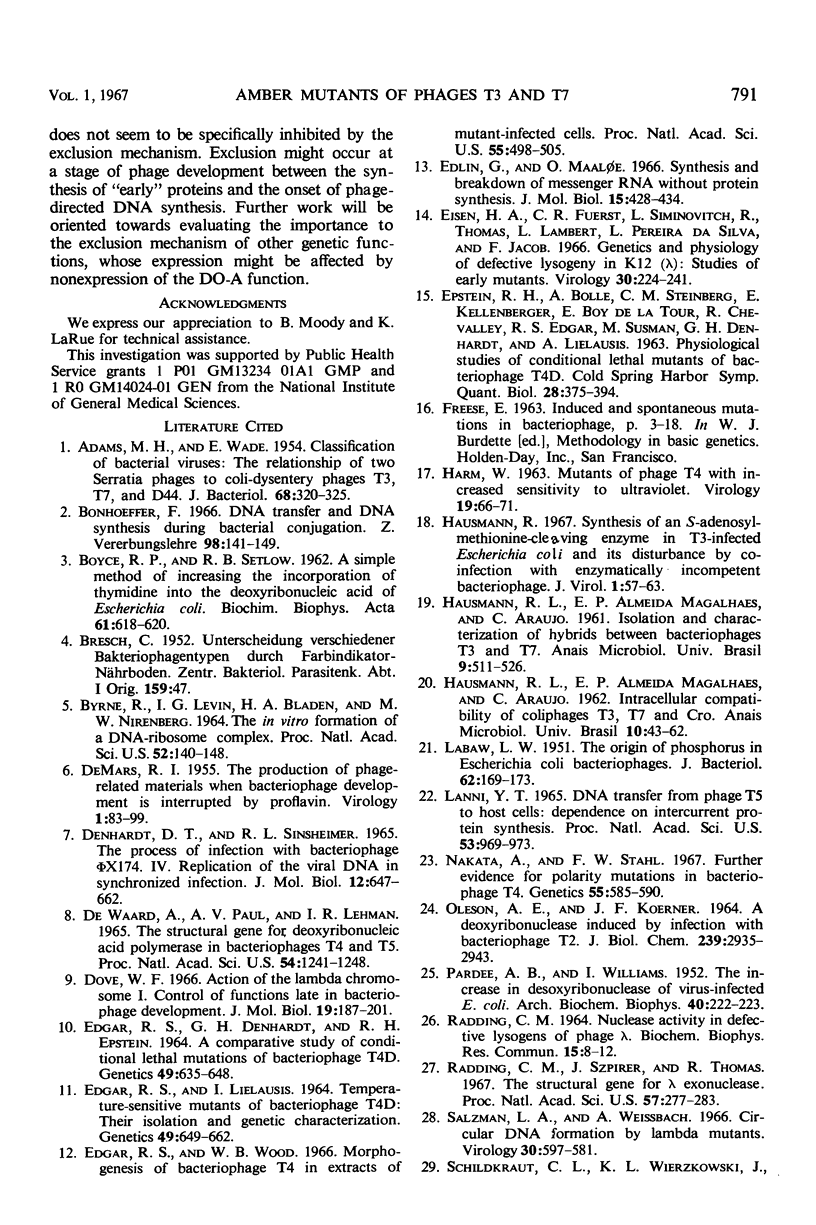
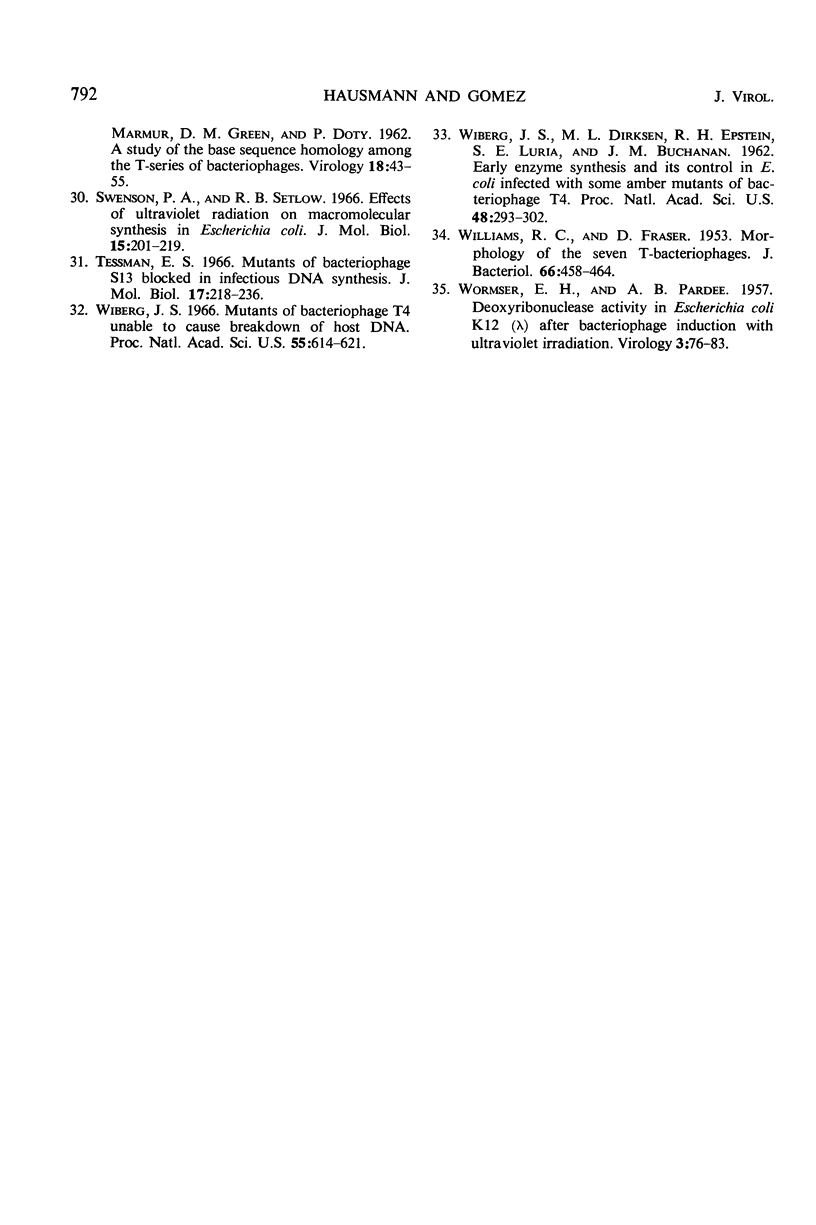
Selected References
These references are in PubMed. This may not be the complete list of references from this article.
- ADAMS M. H., WADE E. Classification of bacterial viruses; the relationship of two Serratia phages to coli-dysentery phages T3, T7, and D44. J Bacteriol. 1954 Sep;68(3):320–325. doi: 10.1128/jb.68.3.320-325.1954. [DOI] [PMC free article] [PubMed] [Google Scholar]
- BYRNE R., LEVIN J. G., BLADEN H. A., NIRENBERG M. W. THE IN VITRO FORMATION OF A DNA-RIBOSOME COMPLEX. Proc Natl Acad Sci U S A. 1964 Jul;52:140–148. doi: 10.1073/pnas.52.1.140. [DOI] [PMC free article] [PubMed] [Google Scholar]
- Bonhoeffer F. DNA transfer and DNA synthesis during bacterial conjugation. Z Vererbungsl. 1966;98(2):141–149. doi: 10.1007/BF00897186. [DOI] [PubMed] [Google Scholar]
- DE MARS R. I. The production of phage-related materials when bacteriophage development in interrupted by proflavine. Virology. 1955 May;1(1):83–99. doi: 10.1016/0042-6822(55)90007-6. [DOI] [PubMed] [Google Scholar]
- De Waard A., Paul A. V., Lehman I. R. The structural gene for deoxyribonucleic acid polymerase in bacteriophages T4 and T5. Proc Natl Acad Sci U S A. 1965 Oct;54(4):1241–1248. doi: 10.1073/pnas.54.4.1241. [DOI] [PMC free article] [PubMed] [Google Scholar]
- Denhardt D. T., Sinsheimer R. L. The process of infection with bacteriophage phi-X174. IV. Replication of the viral DNA in a synchronized infection. J Mol Biol. 1965 Jul;12(3):647–662. doi: 10.1016/s0022-2836(65)80319-9. [DOI] [PubMed] [Google Scholar]
- Dove W. F. Action of the lambda chromosome. I. Control of functions late in bacteriophage development. J Mol Biol. 1966 Aug;19(1):187–201. doi: 10.1016/s0022-2836(66)80060-8. [DOI] [PubMed] [Google Scholar]
- EDGAR R. S., DENHARDT G. H., EPSTEIN R. H. A COMPARATIVE GENETIC STUDY OF CONDITIONAL LETHAL MUTATIONS OF BACTERIOPHAGE T4D. Genetics. 1964 Apr;49:635–648. doi: 10.1093/genetics/49.4.635. [DOI] [PMC free article] [PubMed] [Google Scholar]
- EDGAR R. S., LIELAUSIS I. TEMPERATURE-SENSITIVE MUTANTS OF BACTERIOPHAGE T4D: THEIR ISOLATION AND GENETIC CHARACTERIZATION. Genetics. 1964 Apr;49:649–662. doi: 10.1093/genetics/49.4.649. [DOI] [PMC free article] [PubMed] [Google Scholar]
- Edgar R. S., Wood W. B. Morphogenesis of bacteriophage T4 in extracts of mutant-infected cells. Proc Natl Acad Sci U S A. 1966 Mar;55(3):498–505. doi: 10.1073/pnas.55.3.498. [DOI] [PMC free article] [PubMed] [Google Scholar]
- Edlin G., Maaloe O. Synthesis and breakdown of messenger RNA without protein synthesis. J Mol Biol. 1966 Feb;15(2):428–434. doi: 10.1016/s0022-2836(66)80118-3. [DOI] [PubMed] [Google Scholar]
- Eisen H. A., Fuerst C. R., Siminovitch L., Thomas R., Lambert L., Pereira da Silva L., Jacob F. Genetics and physiology of defective lysogeny in K12 (lambda): studies of early mutants. Virology. 1966 Oct;30(2):224–241. doi: 10.1016/0042-6822(66)90098-5. [DOI] [PubMed] [Google Scholar]
- HARM W. Mutants of phage T4 with increased sensitivity to ultraviolet. Virology. 1963 Jan;19:66–71. doi: 10.1016/0042-6822(63)90025-4. [DOI] [PubMed] [Google Scholar]
- Hausmann R. Synthesis of an S-adenosylmethionine-cleaving enzyme in T3-infected Escherichia coli and its disturbance by co-infection with enzymatically incompetent bacteriophage. J Virol. 1967 Feb;1(1):57–63. doi: 10.1128/jvi.1.1.57-63.1967. [DOI] [PMC free article] [PubMed] [Google Scholar]
- LABAW L. W. The origin of phosphorus in Escherichia coli bacteriophages. J Bacteriol. 1951 Aug;62(2):169–173. doi: 10.1128/jb.62.2.169-173.1951. [DOI] [PMC free article] [PubMed] [Google Scholar]
- Lanni Y. T. DNA transfer from phage T5 to host cells: dependence on intercurrent protein synthesis. Proc Natl Acad Sci U S A. 1965 May;53(5):969–973. doi: 10.1073/pnas.53.5.969. [DOI] [PMC free article] [PubMed] [Google Scholar]
- Nakata A., Stahl F. W. Further evidence for polarity mutations in bacteriophage T4. Genetics. 1967 Mar;55(3):585–590. doi: 10.1093/genetics/55.3.585. [DOI] [PMC free article] [PubMed] [Google Scholar]
- OLESON A. E., KOERNER J. F. A DEOXYRIBONUCLEASE INDUCED BY INFECTION WITH BACTERIOPHAGE T2. J Biol Chem. 1964 Sep;239:2935–2943. [PubMed] [Google Scholar]
- PARDEE A. B., WILLIAMS I. The increase in desoxyribonuclease of virus-infected E. coli. Arch Biochem Biophys. 1952 Sep;40(1):222–223. doi: 10.1016/0003-9861(52)90090-8. [DOI] [PubMed] [Google Scholar]
- Radding C. M. Nuclease activity in defective lysogens of phage lambda. Biochem Biophys Res Commun. 1964 Feb 18;15(1):8–12. doi: 10.1016/0006-291x(64)90093-2. [DOI] [PubMed] [Google Scholar]
- Radding C. M., Szpirer J., Thomas R. THE STRUCTURAL GENE FOR lambda EXONUCLEASE. Proc Natl Acad Sci U S A. 1967 Feb;57(2):277–283. doi: 10.1073/pnas.57.2.277. [DOI] [PMC free article] [PubMed] [Google Scholar]
- SCHILDKRAUT C. L., WIERZCHOWSKI K. L., MARMUR J., GREEN D. M., DOTY P. A study of the base sequence homology among the T series of bacteriophages. Virology. 1962 Sep;18:43–55. doi: 10.1016/0042-6822(62)90175-7. [DOI] [PubMed] [Google Scholar]
- Swenson P. A., Setlow R. B. Effects of ultraviolet radiation on macromolecular synthesis in Escherichia coli. J Mol Biol. 1966 Jan;15(1):201–219. doi: 10.1016/s0022-2836(66)80221-8. [DOI] [PubMed] [Google Scholar]
- Tessman E. S. Mutants of bacteriophage S13 blocked in infectious DNA synthesis. J Mol Biol. 1966 May;17(1):218–236. doi: 10.1016/s0022-2836(66)80104-3. [DOI] [PubMed] [Google Scholar]
- WIBERG J. S., DIRKSEN M. L., EPSTEIN R. H., LURIA S. E., BUCHANAN J. M. Early enzyme synthesis and its control in E. coli infected with some amber mutants of bacteriophage T4. Proc Natl Acad Sci U S A. 1962 Feb;48:293–302. doi: 10.1073/pnas.48.2.293. [DOI] [PMC free article] [PubMed] [Google Scholar]
- WILLIAMS R. C., FRASER D. Morphology of the seven T-bacteriophages. J Bacteriol. 1953 Oct;66(4):458–464. doi: 10.1128/jb.66.4.458-464.1953. [DOI] [PMC free article] [PubMed] [Google Scholar]
- WORMSER E. H., PARDEE A. B. Deoxyribonuclease activity in Escherichia coli K12 (lambda) after bacteriophage induction with ultraviolet irradiation. Virology. 1957 Feb;3(1):76–83. doi: 10.1016/0042-6822(57)90024-7. [DOI] [PubMed] [Google Scholar]
- Wiberg J. S. Mutants of bacteriophage T4 unable to cause breakdown of host DNA. Proc Natl Acad Sci U S A. 1966 Mar;55(3):614–621. doi: 10.1073/pnas.55.3.614. [DOI] [PMC free article] [PubMed] [Google Scholar]


